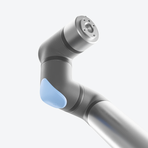India recently became the most populous country in the world. It has one of the world’s largest markets and is well on its way to becoming a powerhouse of manufacturing
Harnessing automation: India’s next manufacturing leap

Sougandh K.M., Country Manager of India, Universal Robots
India recently became the most populous country in the world. It has one of the world’s largest markets and is well on its way to becoming a powerhouse of manufacturing. Manufacturing exports totaled USD 418 billion in 2022, having grown by 40% in a single year
National policies support a tech-driven economy
The explosive growth of manufacturing in India is supported by forward-looking policy makers A number of national initiatives have been introduced to support the sector, including Make in India, Make for the World and the Production Linked Incentive (PLI) scheme, launched in 2020 to boost manufacturing, self-reliance and export revenue.
Under the PLI scheme the government provides financial incentives to manufacturers who increase their production output in specific sectors such as electronics, pharmaceuticals and automotive. These incentive schemes are supporting even small and medium sized businesses – which contribute 30% of GDP – to invest in technology. The public message is clear: technology can and will help industry become more productive.
The country as a whole is undergoing rapid digitization and is well aware of the benefits of automation because of the government’s promotion of Digital India and Industry 4.0. In 2021, India ranked number 10 globally in new robot installations. That openness to technology looks set to take manufacturing in the country to a whole new level of productivity.

Cobots; at the frontier of India’s manufacturing revolution
Collaborative robots, or cobots, are making significant strides in India’s rapidly expanding sectors. The automotive industry was one of the first to automate, but fast-growing electronics and FMCG industries are also adopting cobot automation to reduce costs and increase output and efficiency.
End of line palletizing in India’s enormous food and beverage industry is being transformed as cobots are introduced to lift heavy loads in compact spaces, optimizing the workspace available. There is huge potential too for India’s thriving pharmaceutical sector, where cobots will increasingly be used to pack and palletize medicines.
Unconventional cobot applications support India’s IT service sector
Cobots in India are also used in some less common applications. They prove useful in IT research and development - automating test procedures, assembling and disassembling electronic components and aiding in data collection. By using this technology in India’s thriving IT services hub, researchers can increase efficiency and accuracy, reduce errors and minimize the risk of injury to human workers.

A youthful workforce and technical enterprise: India’s ace cards
When it comes to the future of manufacturing in India, the country has two ace cards up its sleeves - a young population (with a median age of 29 compared to Germany’s 48 and the United States’ 39) and the country’s strong technology sector. It is an economy ‘brimming over with tech-inspired enterprise’. Coupled with widely accessible collaborative automation and Government investment in digitization and industry, the manufacturing sector faces a bright future.
Indian manufacturers - whether in consumer electronics, FMCG, metal and machining, automotive or pharmaceutical industries – are likely to be able to adapt quickly to changing consumer demand and new opportunities. And, while the level of growth predicted for the manufacturing sector will undoubtedly stretch India’s natural resources, ultimately, automation will help the country to increase its manufacturing efficiency and move towards a more sustainable future

*UR India Sales Development and Support Manager, Sougandh Kumarampulakal*

- Universal Robots USA, Inc
- 27175 Haggerty Road, Suite 160
- 48377 Novi, MI